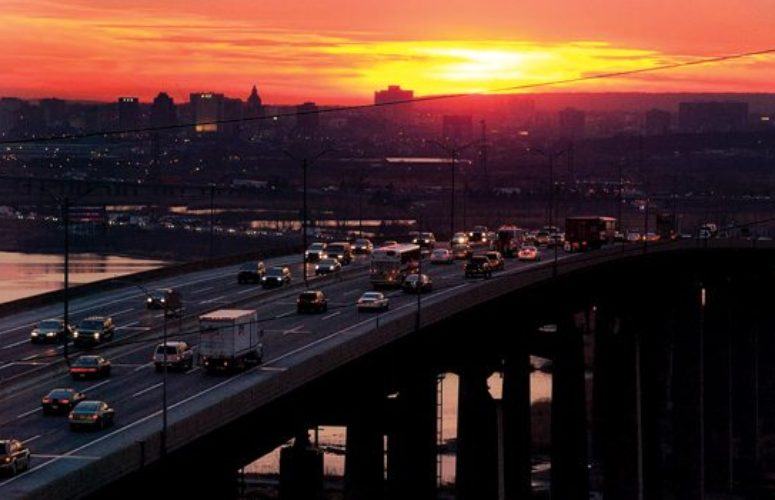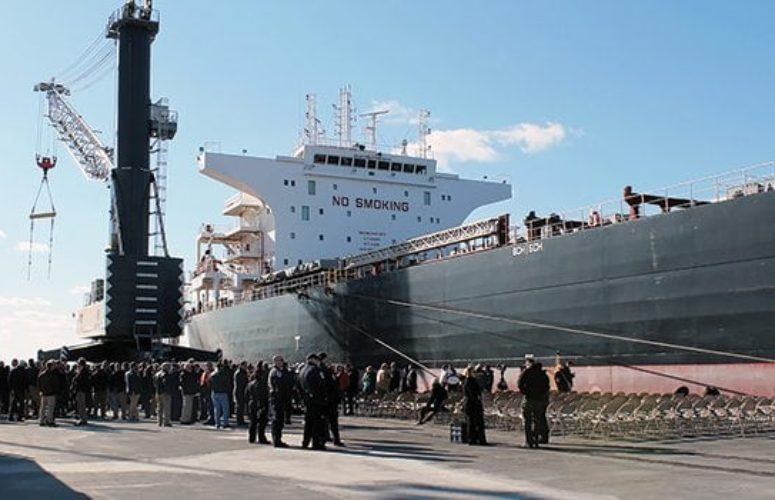
The State of Transportation
More funds are needed to keep our highways and bridges in safe operating order, but ongoing and planned bridge projects and current highway widenings mean commuters and businesses can keep the wheels of commerce rolling … for the time being.
By Tony Hagen, Contributing Writer On Sep 22, 2014It could be described as a bridge too far gone. On June 12, in rural Kingwood Township, a truck carrying a heavy crane on its flatbed attempted to cross a 114-year-old iron truss bridge. The bridge buckled under the load, causing the surface to crinkle into a V-shaped depression, which swallowed the forward part of the truck.
It was what engineers like to call a “fracture critical” situation. The bridge was ready to go. It resulted in an ongoing traffic detour for motorists along Route 519. Fortunately for the state of New Jersey and its drivers, the same did not happen with the Pulaski Skyway, a bridge whose steel supports and concrete surfacing reached the point of extraordinary decay before the state’s Department of Transportation shored up the southbound lanes and took the northbound lanes out of commission for repairs.
“If something like the Pulaski were cut, it would be devastating for transportation flow in New Jersey,” says Greg Lalevee, chairman of Engineers Labor-Employer Cooperative and a board member of the New Jersey Transportation Trust Fund. Just having the northbound lanes of the Pulaski shut for the duration of repairs will result in 40,000 vehicles detoured each weekday, state officials estimate.
In crowded New Jersey, where few new roads are being built and rising traffic places increasing stress on aging highways and bridges, adequate maintenance is becoming a bigger and bigger issue, and the debate over whether the state has adequate funds to handle it is fraught with tension. Engineers, planners and business people tell New Jersey Business that there is a growing crisis of confidence and a rising sense of gloom over the way the state is addressing its infrastructure needs.
“I’m not blaming the elected officials,” says Stephen Boswell, president and CEO of Boswell Engineering, a South Hackensack company that designs and manages the construction of roads and bridges. “I’m saying our needs exceed the funding. Too much essential maintenance is getting deferred, and too much work is being done at a very late stage, which is often the costliest time to do it,” Boswell says.
“The Pulaski is an example of something that’s getting fixed at a tremendous cost,” he says of the $1-billion project, adding that many other needed projects could have been addressed with the savings New Jersey could have realized from early intervention.
State officials take a glass-is-half-full perspective on the roads and bridges situation, pointing to a multi-year, $3-billion investment on major construction projects throughout New Jersey – projects that will restore order to highway systems ravaged by Hurricane Sandy, widen major arteries such as the New Jersey Turnpike, improve flow for bottleneck-stressed motorists, and rewire gnarly highway junctions that, for years, have been living nightmares for those brave enough to drive through them.
The ongoing $900-million Direct Connection project, which will smooth out the confluence of interstates 295 and 76 and Route 42 in Camden County, “will go a long way toward resolving serious safety and mobility problems,” says former DOT Commissioner James S. Simpson.
Simpson also speaks confidently of efforts to bring roads and bridges into tip-top condition, saying that major strides have been made even though the DOT continues to oversee a large inventory of “structurally deficient” bridges (293) and roads in poor condition (42 percent).
But those numbers do not include all of the roads and bridges in New Jersey that are managed by county governments and local municipalities. In the Garden State, quality issues abound on the roads less traveled. The Annual Highway Report, published in 2013 by the Reason Foundation, ranked New Jersey’s highways 46th in the nation and its bridges 35th, based on condition.
Due to the very high cost of making improvements, public entities rely heavily on financial assistance from the state, which puts a strain on transportation funds, as do many of the other projects not related to roads or bridges, but which also fall under the heading of “transportation,” such as airports and railways.
The Transportation Trust Fund, a heavyweight revenue source that was meant to be a big stick in the war on infrastructure needs, has seen its buying power eroded by rising debt needed to pay off past projects. “At the end of the day, the transportation fund is basically on life support and in need of cash infusion. There are philosophical differences on how to do that, but the fact of the matter is it needs to be done,” Lalevee says.
In straight numbers, Lalevee says, the Trust Fund is supposed to provide $1.6 billion in transportation money in fiscal 2015, a spending period that just got started. Unfortunately, $1.2 billion of that is earmarked for debt service, which leaves little monetary muscle for essential work on roads, bridges and other transportation infrastructure, he says.
Adding to the level of concern among business people is that in order to receive federal highway funds, New Jersey has to put up matching amounts, and that becomes more and more difficult to accomplish if the money isn’t available. The very real danger is that federal dollars will head off to other states that do have the ability to ante up, says Phil Beachem, president of the New Jersey Alliance for Action, a consortium of statewide business leaders which attempts to influence governmental policy on key issues.
Like others, Beachem believes that the state is painting itself into a corner on the issue of transportation funding. He notes a growing sense of urgency among state government and business leaders. “I think this is the year that we have to get this thing resolved,” Beachem says.
DOT Acting Commissioner Joseph Bertoni says that the roads and bridges in New Jersey are well maintained and that numerous programs and expenditures are underway to improve safety. He adds that highway statistics on motorist and pedestrian fatalities are on the decline.
“Fatalities on all New Jersey roadways, including city streets, county routes and NJDOT highways, totaled 544 in 2013, a decrease of 8 percent from the previous year,” he says. “Pedestrian fatalities in 2013 fell 18 percent, to 133, while bicyclist fatalities remained constant at 14.”
Despite incidents such as the Kingwood bridge collapse and an abrupt decision in June by Camden County officials to shut down a Lindenwold bridge for emergency structural repairs, Bertoni says the DOT has a systematic, effective program in place to keep bridges functioning and safe.
“These inspections help us evaluate the structural condition of bridge components and the degree to which they meet modern design standards and the degree to which they can handle current traffic volumes. There is not one traffic-carrying bridge in New Jersey that is unsafe. If a bridge were found to be unsafe, we would close it,” Bertoni says.
As for funding, Bertoni points to rising spending on roads and bridges as evidence that New Jersey is paying attention to its infrastructure needs. “Robust investment levels in bridges and roads have been a hallmark of the Christie administration,” he says, adding that the DOT’s fiscal year 2015 program “boosts investments in our roads and bridges that New Jersey residents rely upon for safe and efficient travel to work, school and other daily activities.”
Critics say the amount of funding is nowhere near being adequate and that the DOT is further hamstrung by a staffing shortage. Beachem and others say they would like to see the transportation funding issue come further into the public eye. Only then would there be sufficient support and pressure for governmental officials to take necessary action, they say.
“There needs to be a better public understanding of the magnitude of the problem and how it affects them before you can start talking about solutions to the problem,” he says.
The possibility of a hike in the 10.5-cent state gasoline tax is cited as a solution example. A one-cent increase would bring tens of millions of dollars more into the Transportation Trust Fund, but people oppose an increase on grounds of not wanting to pay more taxes. Proponents say people would be more accepting if people knew how badly the money was needed for the roads and bridges on which they drive.
“The Christie administration, not wanting to advertise the need for a gas tax is not advertising the need for the work to be done,” says Martin Robins, director emeritus of the Alan M. Voorhees Transportation Center at Rutgers University. “The Legislature hasn’t been that adept at finding out the information and presenting it to the public,” he says, noting that efforts to pass bills forcing the DOT to give a fuller accounting of needs and revenues have been unsuccessful.
“If the department were asked to really tell us what really is the need over the next 5 to 10 years, I’m sure it would be at a level that is far in excess of what is now being funded,” says Robins, who, as a former project director of the Access to the Region’s Core (ARC) tunnel, lost a major round when Gov. Christie diverted funding for the Hudson River project to the Pulaski Skyway rehabilitation.
In Christie’s defense, Boswell contends that New Jersey will get more for its dollar with the Pulaski project than it would have with the ARC, where New Jersey’s investment would have supported the growth of many New York businesses. “New York would have contributed next to nothing,” he says.
Pulaski, truth be told, is a boon for New Jersey’s construction industry, as the project will extend through 2020 and represent thousands of jobs. Three regional Port Authority of New York and New Jersey projects are adding to the windfall. The $1.5-billion Goethals Bridge replacement project, set to finish in 2018, is one construction bonanza, bringing 2,250 jobs; and the overhaul of the Bayonne Bridge roadway, also finishing in 2018, will support nearly 2,800 jobs. The $3.9-billion Tappan Zee Bridge replacement, though not in New Jersey, is also viewed as a huge boost for the state’s economy.
“I don’t think we’ve seen this many bridges being done at the same time,” Lalevee says. “We’ve got 150 operating engineers working on the new Tappan Zee Bridge.” More are at work on the others. In the lifetime of a worker, one bridge project like this is an event, but to have three or more ongoing is extraordinary luck, Lalevee says.
And with better management of its transportation funds, New Jersey could keep the dollars flowing to support further economic growth across many industries, he says.
Indeed, there are many worthy projects that are languishing for lack of funds, Robins says. “They are constantly being impeded because there is no adequate funding available.” He cites the proposed extension of the Hudson-Bergen light rail line as one such project that would spur economic development. The Gateway Tunnel, Amtrak’s answer to the need for another railroad tunnel into New York, this time from Secaucus, holds similar potential, Robins says.
Other projects have jumped to the head of the queue by necessity. The ongoing $200-million Route 35 highway reconstruction and the Mantoloking Bridge replacement at the shore are considered vital to the state’s tourism industry, as is the related $350-million Route 72 Manahawkin Bay Causeway. Hurricane Sandy can be thanked for moving the Route 35 and Mantoloking Bridge projects to the front burner. Scheduled completion for Route 35 is 2015, and the Route 72 project will wrap up in 2020. The DOT does not estimate the number of construction jobs involved.
Another major DOT project is the replacement of the 84-year-old Route 7 Wittpenn Bridge in Hudson County, costing $600 million and scheduled for completion in 2017.
On the Delaware River side of the state, the $344-million I-95/Scudder Falls Bridge Replacement Project, encompassing a 4.4-mile section of highway and bridge, continues to inch forward. The current span is not considered wide enough to handle growing traffic volume. Revenue and traffic studies are currently underway – the bridge and its cost would be toll supported when complete. Final bridge design work has not yet begun, and job estimates are not yet possible, according to Delaware River Joint Toll Bridge Commission spokesman Joseph Donnelly.
“The $344-million figure is a gross estimate and is likely to undergo significant refinement once final design for the project gets initiated and completed,” he says.
The Turnpike Authority has numerous projects in the action phase, including widening and restoration work along the Garden State Parkway, bridge work over Great Egg Harbor, and interchanges in Cape May County. These do not represent the entirety of the authority’s capital spending plan this year, but account for $366 million in spending so far in 2014.
A succession of these projects will finish up in the near future, including the parkway restoration from Toms River to Wall, costing $260 million and ending in May of next year. It will result in nearly 3,960 jobs this year. The parkway widening from the Atlantic City Expressway to Toms River is costing $590 million and ending in 2017. It sustained or created 1,200 jobs this year.
And the Great Egg Harbor Bridge rehabilitation and reconstruction project will cost $271 million when it is finished in 2018. It kept 1,400 workers busy this year alone.
Last but not least, the massive, much needed $2.3-billion turnpike widening project will be completed by this Thanksgiving after six years of construction. The effort has created an estimated 4,032 construction jobs this year alone, according to turnpike officials. But that is just a fraction of what it represents to the state’s economy.
“The turnpike, the timing of it through the economic collapse, saved a lot of our people’s livelihoods, and also saved a lot of the businesses we worked for,” Lalevee says.
Related Articles:





